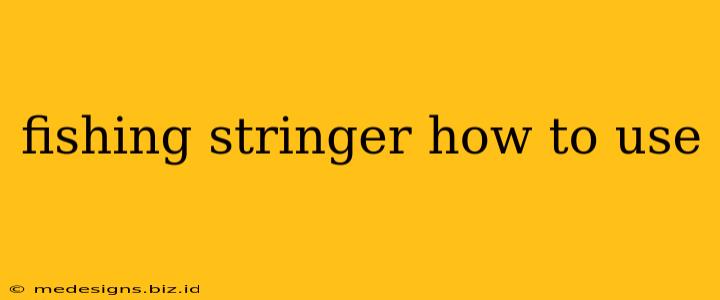So you've had a successful fishing trip and you've caught a few beauties! Now what? Properly storing your catch is crucial, and that's where a fishing stringer comes in. This guide will walk you through how to use a fishing stringer, the different types available, and how to choose the best one for your needs.
What is a Fishing Stringer?
A fishing stringer is a simple yet essential tool for keeping your catch alive and fresh until you're ready to clean and process it. It's basically a length of strong cord or wire with a loop or hook at one end and multiple loops or hooks along its length. You thread the stringer through the lower jaw or gills of your fish to keep it securely in place.
How to Use a Fishing Stringer Properly
Using a fishing stringer correctly is key to keeping your fish healthy and preventing injury. Here's a step-by-step guide:
1. Choosing the Right Stringer:
- Material: Stringers come in various materials, including nylon cord, wire, and even plastic. Nylon is generally gentler on the fish, while wire is more durable. Consider the types of fish you typically catch and the conditions you fish in when making your choice.
- Length: The length of your stringer should accommodate the number of fish you anticipate catching. A longer stringer allows for better spacing between the fish, preventing them from rubbing against each other and getting injured.
- Hooks/Loops: The type of hook or loop design impacts ease of use and how securely it holds the fish. Some have individual loops for each fish, while others have a continuous line.
2. Preparing Your Catch:
- Careful Handling: Gently remove the hook from your fish, avoiding unnecessary stress. Avoid squeezing the fish too tightly.
- Placement: Insert the stringer through the lower jaw or the gills, depending on the type of stringer and fish size. For larger fish, using the gills may be necessary to prevent the stringer from pulling out.
3. Securing Your Catch on the Stringer:
- Proper Spacing: Ensure there is adequate space between fish to allow for water circulation and prevent injury. Overcrowding can lead to fish stress and reduced quality.
- Knots and Security: If your stringer employs knots, ensure they are secure and will not easily loosen or come undone. A reliable knot prevents fish escape.
4. Submerging Your Stringer:
- Keep it Submerged: Always keep the stringer submerged in the water. This helps keep the fish alive and prevents them from drying out.
- Water Movement: Ideally, position your stringer in an area with some water movement to ensure adequate oxygenation.
5. Handling and Storage:
- Careful Retrieval: When you're ready to bring your stringer in, retrieve it slowly and carefully to avoid stressing the fish.
- Immediate Processing: Once you've landed your fish, it's best to clean and process them as quickly as possible to maintain freshness and quality.
Choosing the Right Stringer for Your Needs
The type of fishing stringer you choose will depend on several factors:
- Type of Fish: Larger, heavier fish require a more robust stringer.
- Fishing Style: If you are fishing in fast-moving water, you'll need a sturdier stringer.
- Number of Fish: A longer stringer will be necessary if you anticipate catching multiple fish.
- Personal Preference: Some anglers prefer certain types of stringers based on personal preference and experience.
Types of Fishing Stringers:
- Nylon Cord Stringers: These are generally more fish-friendly, offering a gentler alternative to wire stringers.
- Wire Stringers: Wire stringers are more durable and less likely to break but can injure fish if not used properly.
- Plastic Stringers: Offer a simple and often inexpensive alternative.
By following these guidelines, you can ensure your catch remains healthy and fresh until it's time to clean and prepare it. Remember, responsible fishing practices include the proper handling and care of your catch. Happy fishing!
